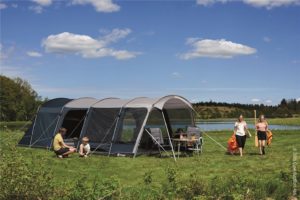

Vaibhav
- Categories: Advice
Are you a nature lover looking to minimise your environmental impact while enjoying the great outdoors? Eco-friendly camping might just be the perfect solution for you.
In this comprehensive guide, we will explore the importance of eco-friendly camping, how to choose an eco-friendly campsite, what to pack for a sustainable trip, ways to reduce waste while camping, sustainable activities to do, and how to practice sustainable food and cooking.
Join us on this journey to leave a positive impact on the environment during and after your camping trip.
Key Takeaways:

- Choose an eco-friendly campsite to minimise your impact on the environment and preserve natural resources.
- Pack light and bring sustainable products to reduce waste and support the local community while camping.
- Practice sustainable activities such as leaving no trace, proper waste disposal, and using reusable items to leave the campsite better than you found it and continue positive environmental impact even after your trip.
The concept of eco-friendly camping, also known as sustainable camping, revolves around the idea of minimising environmental impact while immersing oneself in nature. This practice entails the use of eco-conscious camping equipment, such as the North Face Eco Trail Synthetic sleeping bag, the adoption of sustainable living habits, and deliberate choices aimed at reducing one’s ecological footprint.
By integrating renewable energy sources like solar power for lighting or employing rechargeable batteries for electronic devices, campers can further diminish their carbon emissions. Opting for biodegradable toiletries and cleaning products can contribute to safeguarding the natural surroundings. Additionally, composting food waste and reducing waste through the utilization of reusable containers and utensils are additional eco-friendly measures that campers can include in their outdoor experiences.
Furthermore, embracing the ethos of ‘leave no trace‘ and demonstrating respect for wildlife habitats are fundamental aspects of eco-friendly camping. These practices are essential in ensuring the preservation of natural environments for the benefit of future generations.
Why is Eco-Friendly Camping Important?
Eco-friendly camping plays a crucial role in environmental conservation by helping to protect the environment and preserve wildlife habitats. This practice ensures the maintenance of delicate ecosystems and biodiversity for the benefit of future generations. Implementing principles such as Leave No Trace is essential for minimising the adverse environmental effects of camping activities.
Individuals can actively contribute to reducing their carbon footprint and promoting sustainability by opting for eco-friendly camping options. The Leave No Trace principles underscore the significance of leaving natural spaces untouched, without any evidence of human presence. Preserving the natural state of these habitats is essential for the well-being of plants and animals that depend on them for survival. Human activities, such as littering, habitat destruction, and pollution, pose threats to the balance of ecosystems and the survival of various species.
How to Choose an Eco-Friendly Campsite?
Selecting an environmentally conscious campsite involves choosing locations that prioritise sustainability and operate with minimal impact on natural environments. It is advisable to consider campsites that support local communities, practise sustainable tourism, and opt for off-peak seasons to minimise resource consumption and carbon footprint.
What to Look for in a Campsite?
When selecting a campsite, it is advisable to seek out environmentally conscious sites that prioritise the preservation of wildlife habitats, provide designated camping areas, and employ sustainable energy sources such as solar power. These environmentally friendly campsites not only reduce their environmental impact but also elevate the overall camping experience.
The presence of designated camping areas allows campers to enjoy a sense of seclusion and closeness to nature while safeguarding delicate ecosystems from disturbance. The integration of renewable energy sources like solar power not only mitigates carbon emissions but also establishes a model of sustainability for other campsites to emulate.
The focus on safeguarding wildlife habitats fosters a harmonious ecosystem where both humans and animals can flourish cohesively.
How to Leave No Trace?
The Leave No Trace principles are a set of guidelines aimed at reducing the ecological footprint of camping activities, with a focus on environmental conservation, and the preservation of an authentic outdoor experience for subsequent campers.
These principles provide a framework for responsible outdoor recreation, advocating for thorough trip planning and preparation by campers. The seven principles entail showing respect for wildlife by maintaining a safe distance, proper disposal of waste to prevent environmental contamination, and refraining from disturbing natural elements.
During camping expeditions, it is crucial to minimise the impact of fires by using designated fire rings and limiting fires to small, low-impact sizes.
Travellers are advised to exhibit consideration for other visitors and control noise levels to ensure the tranquillity of the natural environment is maintained for all. Adhering to these principles enables campers to contribute to the conservation of natural beauty in the outdoors for the benefit of future generations.
What to Pack for an Eco-Friendly Camping Trip?
Preparing for an environmentally conscious camping trip involves carefully selecting camping equipment and eco-friendly products that adhere to sustainable principles. Adopting a minimalist approach and choosing reusable, plastic-free items can help reduce your environmental impact.
How to Pack Light and Minimise Waste?
To streamline packing and minimise environmental impact, it is advisable to embrace a minimalist philosophy when it comes to camping preparations. This involves selecting lightweight camping gear and opting for reusable items like water bottles, utensils, and storage containers.
When gearing up for outdoor activities, prioritizing multi-functional items can significantly contribute to weight reduction in your gear. It is beneficial to choose equipment that can serve dual or triple purposes, such as a sleeping bag that can also function as a blanket or a cooking pot that doubles as a mug.
While the upfront costs of investing in high-quality and durable gear may be higher, the longevity of these items mitigates the need for frequent replacements, thereby reducing overall waste production. Reusable products not only diminish your environmental impact but also yield long-term cost savings, rendering them a sustainable choice for any outdoor expedition.
What Sustainable Products to Bring?

For an environmentally conscious camping experience, individuals are urged to consider utilising sustainable equipment such as the Goal Zero Nomad 10 Solar Panel, the igadgitz Waterproof Eco Rechargeable Solar Torch, and environmentally-friendly toiletries like biodegradable soap and shampoo.
These sustainable products play a crucial role in reducing one’s ecological impact while enjoying outdoor activities. The Goal Zero Nomad 10 Solar Panel effectively harnesses renewable solar energy to power electronic devices, thereby decreasing reliance on disposable batteries.
Similarly, the igadgitz Waterproof Eco Rechargeable Solar Torch not only offers illumination without depending on traditional energy sources but also recharges via solar power.
Opting for biodegradable soap and shampoo guarantees that any waste generated during the camping trip will not adversely affect the ecosystem, as these products biodegrade naturally.
How to Reduce Waste While Camping?
Minimising waste during camping involves implementing plastic-free methods, using reusable items, and following sustainable camping guidelines to reduce the amount of waste produced throughout the duration of your trip.
How to Properly Dispose of Waste?
Proper waste management practices during camping involve utilising designated waste disposal areas and recycling facilities to ensure waste is handled in a manner that minimises environmental impact.
A crucial element of waste disposal at campsites involves the systematic segregation of recyclable materials from general refuse. By sorting items such as plastic bottles, paper, and cans into dedicated recycling receptacles, campers play a vital role in reducing the volume of waste destined for landfills.
Adherence to proper protocols for disposing of food waste is paramount, as improperly discarded food items can attract wildlife and disrupt the delicate balance of the natural ecosystem. By conscientiously implementing these modest yet impactful measures, campers contribute to the preservation of the environment and the maintenance of a pristine and enjoyable camping environment for all.
How to Use Reusable Items?
Using reusable items stands out as a simple yet impactful sustainable camping suggestion, as it plays a vital role in waste reduction and the promotion of environmentally-conscious behaviours.
When individuals choose to use reusable water bottles, cutlery, and storage containers during camping trips, they actively contribute to reducing single-use plastics while also benefiting from the practicality and durability of these sustainable products.
For example, opting for a stainless steel water bottle for multiple uses offers a sustainable alternative to constantly buying and throwing away plastic bottles. Similarly, getting a set of reusable cutlery eliminates the need for disposable utensils, thereby reducing overall waste during camping outings.
These small changes together result in significant environmental advantages, ensuring a more sustainable and environmentally friendly camping experience for everyone involved.
What are Some Sustainable Activities to Do While Camping?
Taking part in sustainable activities during camping enriches one’s connection with nature, offering significant outdoor experiences that contribute to wildlife conservation and promote an authentic outdoor lifestyle. Engaging in activities like hiking, bird watching, and involvement in conservation initiatives exemplify this approach.
How to Leave the Campsite Better Than You Found It?
Ensuring the campsite is in better condition than upon arrival aligns with the principle of Leave No Trace, promoting environmental stewardship and contributing positively to the natural environment.
This objective can be achieved by diligently removing all litter and debris, including small items like bottle tops and cigarette ends. It is essential to take away all waste items, leaving no leftovers behind.
Subsequently, the responsible extinguishing of campfires involves thorough extinguishing and ensuring the ashes are completely cold. Any fire circles should be covered, and the remaining ash scattered.
Temporary structures or clotheslines must be taken down, thereby restoring the area to its natural state without artificial constructions. A final check should be carried out to confirm the absence of any signs of human presence, allowing subsequent campers to enjoy an unspoilt wilderness experience.
How to Support Local Businesses and Communities?
Promoting local businesses and communities during a camping trip is an essential component of sustainable tourism, as it encourages environmentally friendly practices and aids in bolstering the local economy.
One method of supporting local economies while camping involves purchasing goods and services from nearby establishments and artisans. By investing in locally sourced products, including fresh produce, crafts, and souvenirs, campers can directly contribute to the economic well-being of residents in the region.
Additionally, choosing accommodations offered by local hosts, such as campsites operated by families or small hospitality enterprises, serves as another avenue for supporting local businesses. This choice not only facilitates the promotion of authentic experiences but also ensures that visitor expenditures remain within the community, thereby enhancing its overall economic viability.
How to Practice Sustainable Food and Cooking While Camping?
Engaging in sustainable food practices and cooking methods during camping involves strategising meals to minimise food waste, sourcing ingredients from sustainable agricultural sources, and exercising caution in water usage. Additionally, supporting local economies by obtaining locally-sourced food items is a key aspect of this approach.
How to Plan Meals and Reduce Food Waste?

Efficient meal planning is a fundamental aspect of minimising food wastage during camping expeditions. This practice not only aligns with sustainable living principles but also ensures the judicious utilisation of reusable resources.
During the meal planning process for a camping trip, it is advisable to engage in ingredient preparation beforehand to prevent the unnecessary overpacking of food supplies.
Opting for versatile ingredients that can be utilised in a variety of dishes helps in reducing the overall quantity of individual items required. Additionally, creative utilisation of leftover ingredients can prevent avoidable wastage.
Furthermore, the adoption of reusable containers, utensils, and cutlery presents a viable solution for minimising single-use plastic waste.
By incorporating these waste-reduction approaches into one’s camping meal preparation routine, individuals can actively contribute to a more sustainable environment, while simultaneously enhancing the efficiency of their outdoor culinary endeavours.
How to Cook with Sustainable Methods?
Cooking with sustainable methods entails utilising eco-friendly cooking equipment such as the BioLite CampStove, which is designed to reduce water consumption and make use of renewable energy sources.
Alongside the BioLite CampStove, solar-powered cookers present another environmentally friendly option that harnesses sunlight to heat and cook food without dependence on electricity. These cookers prove to be particularly effective for outdoor activities or in situations where traditional energy sources are scarce.
By integrating these renewable energy sources into cooking practices, individuals can decrease their carbon footprint and play a role in promoting a healthier environment. Simple actions like covering pots during cooking, utilising pressure cookers to conserve time and water, and selecting energy-efficient appliances can further aid in minimising water usage in the kitchen.
How to Leave a Positive Impact on the Environment After Your Camping Trip?
Ensuring a positive environmental impact following a camping trip involves the implementation of environmental stewardship, restoration of the campsite, and ongoing adoption of sustainable practices conducive to establishing a harmonious relationship with nature.
How to Properly Clean Up and Restore the Campsite?
Thoroughly cleaning and restoring the campsite is in alignment with the Leave No Trace principles, which play a significant role in waste reduction and minimising environmental impact.
An essential step in ensuring a comprehensive campsite cleanup involves meticulous inspection of the area for any litter or debris that may have been left behind. It is imperative to conduct a thorough search around the site, including under bushes, between rocks, and within fire rings, to gather all rubbish.
Additionally, all remnants of food should be collected to prevent disturbances to wildlife. Proper disposal of all waste, including biodegradable items such as fruit peels, is imperative.
By departing from the campsite in a condition cleaner than its initial state, individuals not only help in preserving the natural aesthetics but also set a commendable example for others to emulate.
How to Continue Sustainable Practices in Everyday Life?
The promotion of sustainable practices in daily life involves the adoption of an eco-conscious mindset and the incorporation of environmentally friendly practices aimed at reducing one’s carbon footprint and advocating for sustainable living.
One practical recommendation is to prioritise the reduction of household energy consumption by utilising energy-efficient appliances and ensuring that lights and electronics are switched off when not in use.
Another approach to embracing a more eco-conscious lifestyle is to choose sustainable transport options such as walking, cycling, or using public transport.
Engaging in recycling and composting activities can significantly reduce waste production and help minimise one’s environmental impact.
Through the implementation of minor adjustments in daily routines, individuals can actively contribute to a greener and more sustainable future.
Frequently Asked Questions
What are some tips for eco-friendly camping?
Some tips for eco-friendly camping include using reusable items, packing a waste management kit, using biodegradable and eco-friendly products, and leaving no trace behind. It’s also important to be mindful of energy and water usage, and to support local businesses and sustainable tourism practices.
How can I leave no trace while camping?
Leaving no trace while camping means leaving the campsite in the same condition as you found it. This includes properly disposing of waste, not damaging plants or wildlife, and not leaving any litter behind. It’s important to follow the principles of “pack in, pack out” and to respect the natural environment.
What are some eco-friendly products for camping?
Some eco-friendly products for camping include reusable water bottles and utensils, biodegradable soap and cleaning products, solar-powered chargers, and eco-friendly insect repellent. It’s also important to choose tents and camping gear made from sustainable materials.
How can I make my camping trip more sustainable?
There are several ways to make your camping trip more sustainable. Some tips include using public transportation or carpooling to reduce carbon emissions, choosing eco-friendly campgrounds, supporting local businesses, and practicing sustainable waste management. It’s also important to educate yourself and others about eco-friendly camping practices.

Share:
By submitting your email address, you are agreeing to receive marketing emails from theexpertcamper.co.uk.
We’ll never share your email address and you can unsubscribe at any time. Privacy policy
Related Posts

A Seasonal Guide To Hiking In The Peak District
Are you ready to lace up your hiking boots and explore the stunning landscapes of the Peak District? This seasonal guide will take you through

Hiking Challenges Preparing For Your First Ultrahike
Are you ready to take your hiking adventures to the next level? Ultra-hiking offers a unique combination of physical and mental challenges, breathtaking scenery, and

Ecofriendly Hiking Tips For Sustainable Adventures
Are you an outdoor enthusiast looking to minimise your impact on the environment while enjoying the great outdoors? Eco-friendly hiking is the perfect solution! We

The Best Hiking Trails For Experiencing UK Wildlife
When exploring the picturesque hiking trails of the UK, you can expect to encounter a diverse array of wildlife. From majestic birds soaring overhead to

Wildflower Walks The Best Trails For Nature Lovers
Are you a nature lover looking to embark on a wildflower walk? Explore the best trails for wildflower walks, including [Trail Name 1], [Trail Name

























